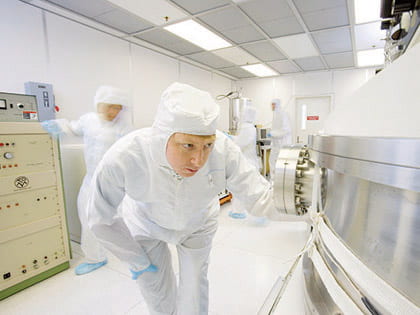No small feat
UCI’s nanotechnology breakthroughs are tiny but critical steps toward improved health care, communications

Peter Burke saw the future – his future – take shape five years ago. He listened to a speech at Caltech in Pasadena by then-President Bill Clinton on the promise of nanotechnology and just knew.
“The president was launching the ‘National Nanotechnology Initiative’ and I had a gut feeling it was the next area to get into, the new frontier,” recalls Burke, who heads the nanotechnology program at UCI’s Henry Samueli School of Engineering. “I’ve watched this boom of interest and the growing fascination people have with nanoscience. I know it’s changed my life and I’m just hoping to make a contribution.”
Some might consider that a bit of understatement from Burke, an associate professor of engineering and computer science. With the help of graduate student Zhen “Jenny” Yu, Burke’s research took a leap recently when they created the world’s longest electrically contacted nanotubes, a microscopic technology that could lead to supercomputers three times faster than today’s. The breakthrough also could improve wireless networks and cellular phone systems.
“This helps anything that has a circuit, anything for communications,” says Burke.
LIGHTNING FAST
He showed for the first time that carbon nanotubes can route electrical signals on a chip faster than traditional copper or aluminum wires, at speeds of up to 10 GHz. As for size, the numbers are hard to imagine. A nanotube is only a few nanometers wide; a nanometer is one billionth of a meter, about the size of 10 atoms strung together.
“That’s about 100,000 times smaller than the width of a human hair,” he explains. “Or another way, 10,000 times smaller than an individual cell.”
Burke’s work generated much attention in the nano-community when his findings were published in Nano Letters, an influential peer-reviewed journal of the American Chemical Society. But reaching the threshold of atom-sized engineering is not the only inverted universe UCI is exploring. The Integrated Nanosystems Research Facility, lead by Professor G.P. Li, is investigating everything from biomedical to chemical to engineering applications.
“The INRF was formed in 1999 as a visionary facility, as a place that would see what’s coming,” says Li. “Under this vision, we need to integrate across various disciplines. We want to learn from the micro nano-systems in nature and then apply them to our lives.”
The media and public have been fascinated with speculation of a day when nano-robots could be injected into our bodies to fight cancers or other diseases. Or nano-particles might be programmed with information gleaned from our individual DNA to extend life by decades, perhaps longer.
“That’s a long way off,” Li admits, “but it’s all an evolution, a very exciting process. We have to take steps to get there.”
The achievements of Burke and his researchers point to one of the paths. Theoretically, nanotubes could replace the copper wiring now used in semiconductor chips to pass electricity through the chip’s various layers (think of the floors of a building). But convincing the industry to make such a huge change is all about economics. Burke notes that mass-producing nanotubes at a reasonable price is a paramount goal, but he doesn’t see a “eureka!” moment any time soon.
At this stage, producing a pound of nanotubes costs roughly the same as a pound of gold, about $5,000 depending on price fluctuations. Just too expensive. And there’s another issue: Leading companies like Intel and Advanced Micro Devices recently shifted from aluminum to copper for their chip wiring, and it’s unlikely they would overhaul again unless it made financial sense. Nonetheless, Manny Vara, a senior technology strategist with Intel’s microprocessor technology lab, says Burke’s work is intriguing and should be applauded as “research that truly and significantly moves the industry forward.”
PRECISE AND PRECIOUS
It’s time-consuming and, even Burke concedes, hit-
and-miss. Everything begins in the cutting-edge lab. A furnace is heated to 1,000 degrees Celsius and atom-sized particles of iron are added, followed by a flood of natural gas containing carbon atoms. A chemical reaction creates nanotubes, which have been produced in labs at many other universities and scientific institutions since 2001. The ingredient that resulted in Burke’s longer nanotubes? Gold.
“Jenny was experimenting by putting a thin film of gold underneath it all,” Burke recalls. “To be candid, we’re not exactly sure why gold made a longer nanotube, but it did. We can move on from this.”
As Burke reflects on the future, he has the demeanor of a scientist – studious, exact and, more often then not, solemn. But ask Burke something like, “is there any pleasure, any joy in your research?,” and he grins broadly. “Oh, yes, it’s a lot of fun,” he says, starting to laugh. “You have to have patience and persistence, for sure, but it’s fun. I’m really looking forward to what’s coming next.”


